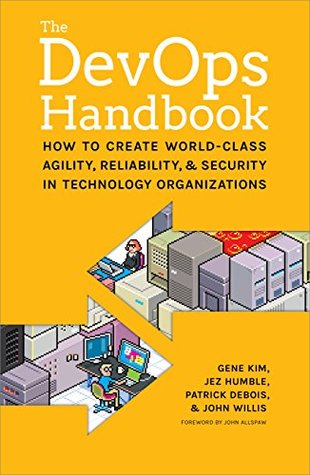More on this book
Community
Kindle Notes & Highlights
by
Gene Kim
Our goal is to enable market-oriented outcomes where many small teams can quickly and independently deliver value to the customer.
All the platforms and services we provide should (ideally) be automated and available on demand, without requiring a developer to open up a ticket and wait for someone to manually perform work.
“Without these self-service Operations platforms, the cloud is just Expensive Hosting 2.0.”
create a platform that provides a shared version control repository with pre-blessed security libraries, a deployment pipeline that automatically runs code quality and security scanning tools, which deploys our applications into known, good environments that already have production monitoring tools installed on them.
It’s okay for people to be dependent on our tools, but it’s important that they don’t become dependent on us.”
immutable infrastructure
environment are no longer allowed—the only way production changes can be made is to put the changes into version control and re-create the code and environments from scratch. By doing this, no variance is able to creep into production.
They set up a continuous build and religiously kept it passing.
They set up test coverage monitoring and ensured that their level of test coverage went up over time.
They wrote up policy and testing guides, and insisted that contributors both inside and out...
This highlight has been truncated due to consecutive passage length restrictions.
Google is engineering professionalism and a high-trust culture that assumes everyone wants to do a good job, as well as the ability to detect and correct issues quickly.
Because of this, we may build our performance testing environment at the start of any project and ensure that we dedicate whatever resources are required to build it early and correctly.
“We prioritize the team goals over individual goals—whenever we help someone move their work forward, we help the entire team.
if we discover a defect in our acceptance tests, we should write a unit test to catch the problem. Similarly, if we discover a defect in exploratory testing, we should write a unit or acceptance test.
20% on detailed planning
Everyone works in the same common area. There are no branches, just a long, unbroken straight line of development.
Here is one last troubling side effect of large batch size merges: when merging is difficult, we become less able and motivated to improve and refactor our code, because refactorings are more likely to cause rework for everyone else.
when we do not aggressively refactor our codebase, it becomes more difficult to make changes and to maintain over time, slowing down the rate at which we can add new features. Solving this problem was one of the primary reasons behind the creation of continuous integration and trunk-based development practices, to optimize for team productivity over individual productivity.
Trunk-based development
Gatekeeper, the Facebook feature toggling
strangler application
The Art of Monitoring
outlier detection,
Server Outlier Detection process,
“Alert fatigue is the single biggest problem we have right now…We need to be more intelligent about our alerts or we’ll all go insane.”
The Practice of Cloud System Administration: Designing and Operating Large Distributed Systems
Application level: increasing web page load times, etc. OS level: server free memory running low, disk space running low, etc. Database level: database transaction times taking longer than normal, etc. Network level: number of functioning servers behind the load balancer dropping, etc.
R code (another statistical package)—this
Believe it or not, our biggest challenge was getting developers to overcome their fear of deploying their own code!
Two major tenets of Lean were the deeply held belief that lead time (i.e., the time required to convert raw materials into finished goods) was the best predictor of quality, customer satisfaction, and employee happiness; and that one of the best predictors of short lead times was small batch sizes, with the theoretical ideal being “single piece flow” (i.e., “1x1” flow: inventory of 1, batch size of 1).


